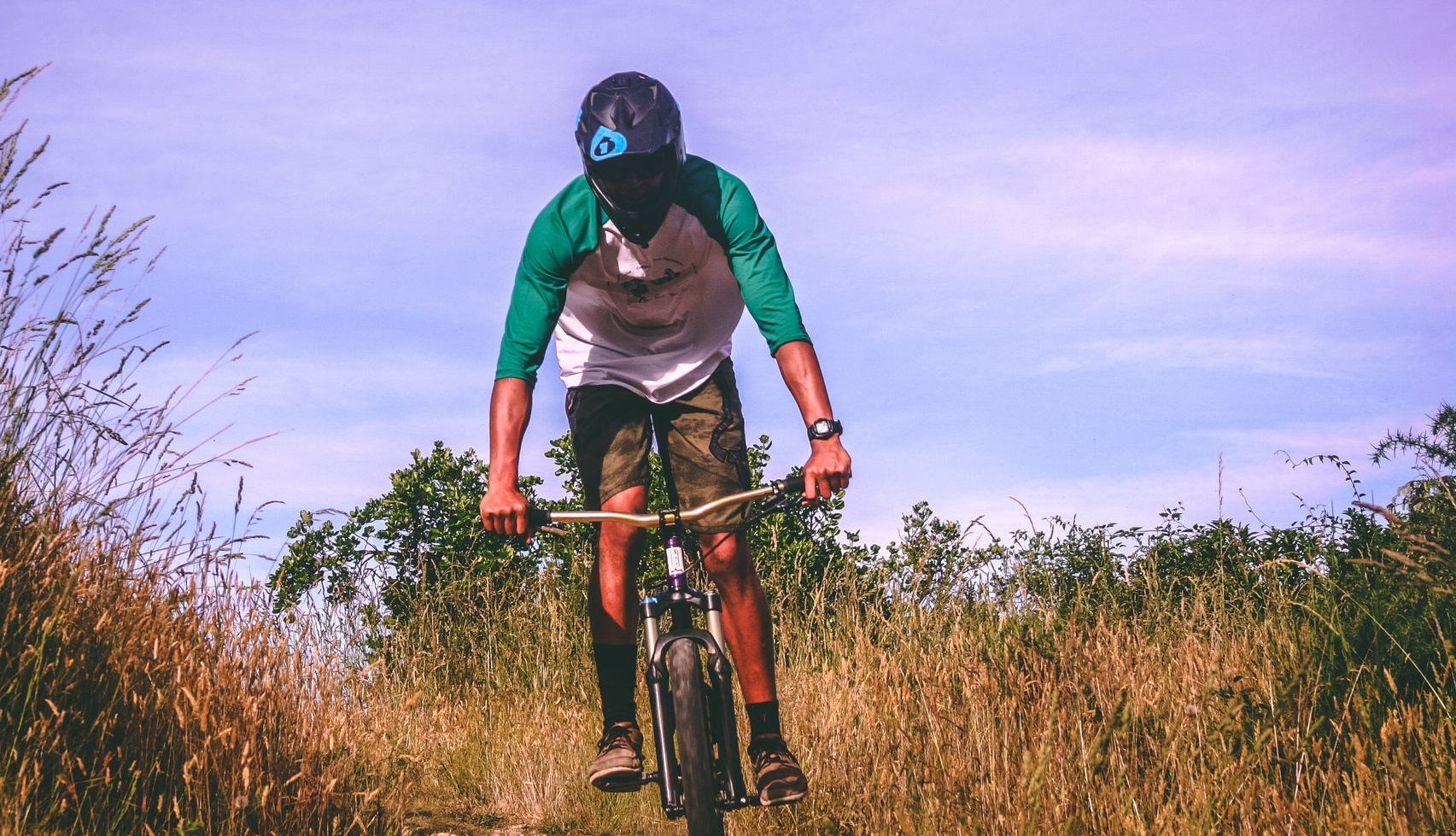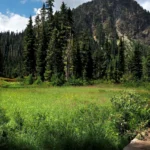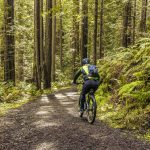If you’ve new to mountain biking, you may wonder what people mean when they talk about mountain bike trail riding. What makes it different than XC trail riding for instance?
Mountain bike trail riding is an adrenaline-packed version of XC trail riding. Trail riding has rigorous singletrack paths and technical features that replace the more sedate fire roads that XC riding is known for. Many times these mountain bike trails are downhill paths that incorporate a lot of adventure into the ride.
In my opinion, trail riding is where the fun is at. Find your local trails, pack your biking gear, and enjoy what I consider some of the best fun. For those just starting out in mountain biking, I put together a guide here to help you get started.
What Makes Trail Riding Different than Cross Country Bike Riding?
XC bike riding is more about speed and how long it takes to complete.
Trail riding has all of the same things as XC riding, but there are also bigger obstacles and challenge to overcome. Trail riders generally look for more adrenaline-pumping paths that have jumps, drops, and rocks to mix things up.
XC riders tend to compare times or compete in cross country races, where Trail riders tend to compare completed obstacles like if they made the big jump or the big drop.
Cross country trails do also tend to be a mix of elevations – some uphill, some downhill, it’s all part of the goal. Trail riders absolutely prefer downhill more with a bit of speed.
Do take note that I talk about both of the trails and mountain bikers in the general sense of the term to give a rough idea of what to expect but by no means does it cover all riders or paths.
Are Trail Bikes different than Cross Country Bikes and Enduro Mountain Bikes?
Yes, quite a bit. Trail bikes and cross country mountain bikes have two very different purposes as you can read more in my post right here on xc vs trail bikes.
On a trail bike, the rider tends to sit more upright to help shift weight on technical trails easier, whereas an XC bike is more geared toward speed so the rider leans a bit more forward.
Trail bikes have a full front suspension travel and often a general rear suspension, though the hardtail variety of trail bikes have zero rear suspension. XC bikes tend to have a medium front suspension and either a medium or zero suspension travel in the rear.
Enduro mountain bikes are actually fairly similar to trail bikes in many ways. The big difference is the wheelbase length. Enduro bikes have a longer wheelbase which increases stability at speed. Cross country bikes don’t have the same stability on downhill trails with their shorter wheelbase, compared to the longer travel Trail and Enduro bikes
What Bike Should You Use?
As you might expect, you’ll want a trail bike for trail riding. In many places along these paths you are going to get airborne and you want to make sure the bike can handle it.
There are options for how to setup the bike. Obviously you’ll want the standard front suspension with around 4-6 inches of travel. For the rear, there are two options because this isn’t a mountain downhill path. Generally I would recommend a hardtail bike so that you aren’t fighting the suspension to keep the bike moving. Especially when having to go uphill at times, a full rear suspension can waste a lot of energy.
So that means you want a hardtail (no suspension) or a trail bike where you can lockout the rear suspension. While you can run a bike with full suspension, it may just make it harder to run in that configuration. It really depends if you want power or comfort.
Can You Make a Cross Country Bike OK to Use on Downhill Trails?
This is actually a tough one since XC bikes can handle a majority of the downhill and more mild trails fine, but they are just not as well suited to jumps over say 2 foot high or drops of over 2 foot, and that is pushing it really. I actually address this issue more completely in my post on whether a XC bike can handle jumps.
There are many people using XC bikes on many downhill trails and just avoiding the big jumps and drops to spare the bike frame from damage. The one big thing you can do is protect your carbon fiber downtube from getting damaged by flying rocks by covering it with either a guard or cutting apart a plastic bottle and zip tieing it to the downtube to protect the carbon fiber.
There are some things you can’t change on a cross country bike to make it more like a trail bike. For instance, the head tube angles on a trail bike are more relaxed than on a cross country bike which give it a longer wheelbase. The frame is part of what makes the bikes inherently different, but how you handle the bike is fully in your control.
Other than that, if you do choose this route just take it easy over rough terrain.
What Safety Equipment Do You Need?
You’ll want a lot of the same equipment you use if you’re running the big downhill trails.
You’ll want:
- A full face helmet with Consumer Product Safety Commission(CPSC) rated tests. Definitely make sure it has the CPSC so that you know it has passed the proper tests and will definitely protect your head. The link to the helmets is to my blog post on what to look for to ensure you have a real helmet. While a full face helmet is recommended, there are many half helmets that have amazing protection.
- Glasses or goggles to protect your eyes. While most often injuries would come from branches hitting you in the face, sometimes it can be mud or slush even. For $20 it’s well worth it to protect your eyes.
- Padded biker shorts are sure handy. They are not 100% necessary, especially as you will quite often be on your feet on the pedals, but trails tend to be bumpy and it’s certainly a worthwhile investment.
- Riding gloves to cover your hands from the branches and such. These have the added bonus of helping you grip the handlebars even with sweaty hands which may be the difference between a crash or not.
- A good pair or mountain biking shoes. You’ll want to make sure your feet stay on the pedals. I devoted an entire post to this right over here.
Of course, all of this is in addition to a bike that is the right size for you and adjusted so that you can ride it comfortably.
Many of these items I cover in far more detail in my post on the 12 essential pieces of gear for biking. It may sound like a lot of equipment and maybe too much, but do remember that mountain biking can be a dangerous sport but if you take the proper precautions it hugely cuts down on the chance of getting injured.
If you decide you want to try biking after dark, keep in mind that mountain biking at night can be dangerous unless you pick up some essentials like a strong light and reflector tape.
What Should You Bring with You?
No matter what trails you go on, you need to bring along a backpack with some essentials in case of a mechanical failure or getting hurt.
- A basic repair kit with tools to tighten bolts, tire tube patches, an air pump, etc. Tires do get holes and you’ll definitely need to patch them sometimes. This really helps you from getting stranded and walking all the way back.
- A first-aid kit. You’ll want bandages, anti-septic wipes, cotton gauze, and tweezes as a starting point. One thing often forgotten is to pack a whistle. If you are unable to get around, yelling for help will just result in you losing your voice if you are loud enough. A whistle will cut through the surrounding area and people will be able to hear you without you exerting extra energy. ALWAYS bring a whistle with you.
- Water or a hydration backpack. If you get dehydrated, you’ll get tired, and the chance of injury greatly increases.
- Snacks to keep up your energy. Snacks like Clif bars are great to bring.
- Duck tape and zip ties so you can fix anything
- A cell phone
There are even more essential items to bring in your biking kit in another post I put together which is a good read whether you’re a beginner or a seasoned rider. Always be prepared and have another rider along.
So I hope that gives you an idea what trail riding is, and what bike, safety equipment, and gear you’ll need to ensure you have a great time out there.






